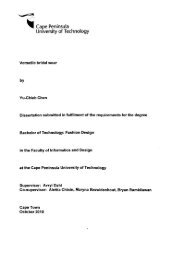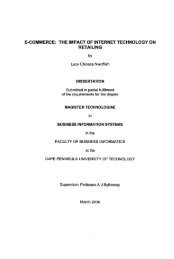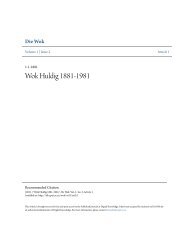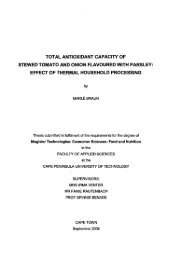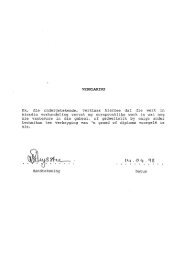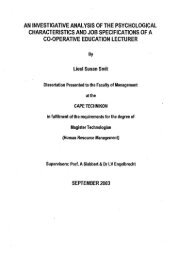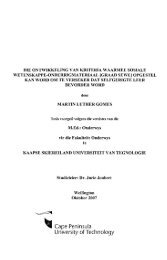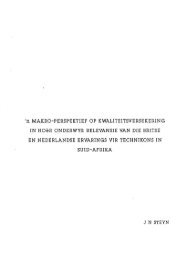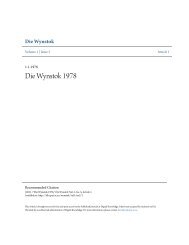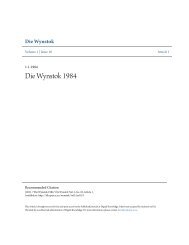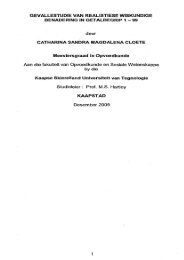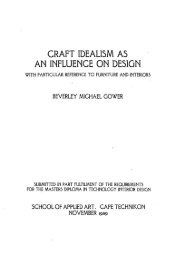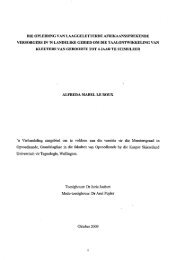the effect of the particle size distribution on non-newtonian turbulent ...
the effect of the particle size distribution on non-newtonian turbulent ...
the effect of the particle size distribution on non-newtonian turbulent ...
You also want an ePaper? Increase the reach of your titles
YUMPU automatically turns print PDFs into web optimized ePapers that Google loves.
3.1 INTRODUCTION<br />
CHAPTER 3<br />
EXPERIMENTAL WORK<br />
The test work was c<strong>on</strong>ducted at <str<strong>on</strong>g>the</str<strong>on</strong>g> University <str<strong>on</strong>g>of</str<strong>on</strong>g> Cape Town's Hydrotransport Research<br />
Facility. The test facilities used included a pumped recirculating pipe test rig known as <str<strong>on</strong>g>the</str<strong>on</strong>g><br />
East Rig and a pipeline rig known as <str<strong>on</strong>g>the</str<strong>on</strong>g> Mini Rig.<br />
In large scale pipe testing (as used for this study), slurry is pumped in a looped circuit<br />
normally c<strong>on</strong>sisting <str<strong>on</strong>g>of</str<strong>on</strong>g> two pipe diameters, over a wide range <str<strong>on</strong>g>of</str<strong>on</strong>g> velocities. This is d<strong>on</strong>e in<br />
order to measure <str<strong>on</strong>g>the</str<strong>on</strong>g> behaviour <str<strong>on</strong>g>of</str<strong>on</strong>g> <str<strong>on</strong>g>the</str<strong>on</strong>g> slurry (rheology) and <str<strong>on</strong>g>the</str<strong>on</strong>g> <strong>turbulent</strong> pipe flow head loss<br />
which are needed in designing a piping system. Rheological data which is obtained from<br />
laminar flow data can be used to predict <strong>turbulent</strong> pipe flow head loss (Slatter, 1994).<br />
The test facilities which were used c<strong>on</strong>sisted in total <str<strong>on</strong>g>of</str<strong>on</strong>g> four different pipe diameters namely<br />
a 25mm, 80mm, l50mm and 200mm nominal bore. Slurries were tested at mean velocities<br />
ranging froI11 O,lrn/s to 6.2rn/s. Slurries tested included kaolin clay, a mixture <str<strong>on</strong>g>of</str<strong>on</strong>g>kaolin clay<br />
and rock flour (mixture 1) and a mixture <str<strong>on</strong>g>of</str<strong>on</strong>g> kaolin clay, rock flour and silica sand (mixture<br />
2) at varying ratios.<br />
3.2 TESTING FACILITIES<br />
3.2.1 The East Rig<br />
Figure 3.1 depicts a schematic diagram <str<strong>on</strong>g>of</str<strong>on</strong>g> <str<strong>on</strong>g>the</str<strong>on</strong>g> pumped recirculating pipe test rig.<br />
(a) Pump Specificati<strong>on</strong><br />
Slurry is supplied to <str<strong>on</strong>g>the</str<strong>on</strong>g> East Rig by a four bladed Ma<str<strong>on</strong>g>the</str<strong>on</strong>g>r and Platt 8x6, solids<br />
handling pump, which is driven by a variable speed hydraulic drive (Figure 3.2).



